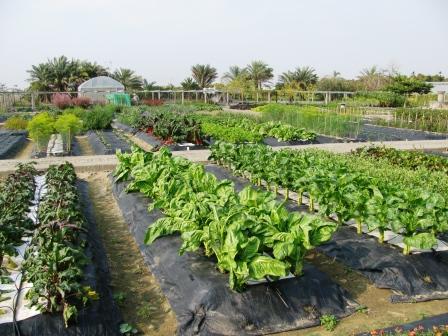That’s the question posed by the title of a big splash in Nature. The answer, in case you don’t want to work your way through the various contributions, as summarized in a handy pamphlet, is yes, by enabling sustainable intensification, although not on its own. So nothing wildly new there. Also not new is that once again agrobiodiversity gets the shaft. One of the articles does focus on plant breeding, but it doesn’t mention the need to ensure the long-term availability of its raw material — crop and livestock genetic diversity, including that in genebanks. There’s also a piece by Jeffrey Sachs and numerous co-authors on the need for better global monitoring of agriculture, which doesn’t mention the desirability of monitoring levels of agricultural biodiversity on-farm. Oh well.
Nibbles: Oil palm, Breadfruit, Barcoding, Guyana genebank, Wheat and heat
- Palmhugger, an oilpalm advocacy group, likens Greenpeace to Goebbels. Who are they really? CIFOR is linking to them on Facebook, so they’re probably kosher, right?
- Nice story on breadfruit in Hawaii.
- More barcoding stuff.
- Reader: We must have a bank of seeds of our fruits and vegetables. Minister of Agriculture: We do!
- Australian wheat boffins: “Adaptation strategies need to be considered now to prevent substantial yield losses in wheat from increasing future heat stress.”
AVRDC’s treasure trove of diversity
I was recently at AVRDC headquarters in Taiwan and was quite taken with their demonstration garden. (Among other things. The genebank operation is also impressive, and recovering from a recent unfortunate setback.) It’s a wonderful display of both vegetable diversity and cultivation systems. I was going to blog about it, but then life intervened, or at least work did. Anyway, the latest issue of AVRDC’s newsletter has a piece on the garden, and they have kindly agreed for us to reprint it here, as the newsletter itself is not available online. Which kinda gets me off the hook. The photographs are mine. The following text (and this post’s title) are courtesy of AVRDC.
Although there are thousands of plants people can consume, humanity relies on only a relative handful for food. Indigenous vegetables — whether semi-wild or domesticated — can greatly expand the menu. Grown primarily in their centers of origin or introduced in a given area, indigenous or traditional vegetables provide food in times of scarcity for the world’s poorest people, yet these hardy, nutritious species often are underutilized.

What began in 2001 as an experimental field on the grounds of the AVRDC headquarters campus in Shanhua, Taiwan has blossomed into a 0.63-hectare living example of the mission and work of AVRDC — The World Vegetable Center.
“The Demonstration Garden was designed as an observation plot for indigenous vegetables when we got the project from the Taiwan Council of Agriculture in the beginning,” said Mandy Lin, an assistant specialist in AVRDC Global Technology Dissemination. After 10 years of development, more than 60 different species of indigenous vegetables are cultivated in 200 plots of various sizes and shapes to showcase the special qualities of each species and promote their wider use. The range of species grown also maintains visual interest as the seasons change.
The indigenous vegetables in the garden were selected for three significant characteristics—ease of cultivation (low input), nutritional quality, and resistance to pests and diseases. Visitors touring the Demonstration Garden often are surprised by the number and variety of indigenous vegetables, and the different edible parts, from shoots and leaves to pods and seeds. “We want to convey a simple but principal message to every visitor—that a diverse diet including many different vegetables is beneficial to health,” Mandy said.
In July 2008 the Center’s Global Technology Dissemination group expanded the function of the Demonstration Garden to highlight four major mature technologies: low-cost drip irrigation, starter solution, grafting chambers, and protective shelters. Farmers in developing countries can adopt these technologies to increase yields, improve produce quality, and reduce production costs.
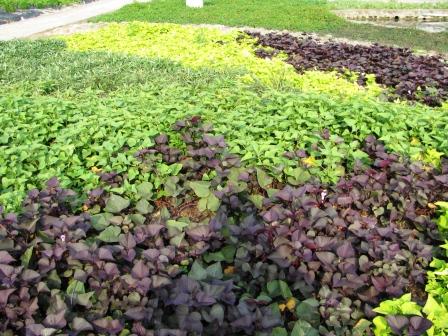
Visitors and AVRDC staff members alike gain new ideas and inspiration as they walk through the garden, enjoy the rich diversity of plants, and see farming technologies in use. As Mandy observed: “You think you are taking care of crops, but in fact they educate you with their beauty and variety.”
Genebanks shenebanks
Why bother building and maintaining huge robotic genebanks, I hear you ask? They’ll just take over the world and we’ll end up having to deal with the Terminator in a few years’ time, no? Well, as it happens there are two pieces today on the Worldwatch Institute’s blog which explain the reasons. Yassir Islam of HarvestPlus says that researchers are “scour[ing] seed banks to find seeds that contain the desired nutrients and then breed these into popular varieties using conventional methods.” And Cary Fowler of the Global Crop Diversity Trust turns to Ug99:
Where do you suppose scientists are looking for a way to deal with the disease? Just as Professor Borlaug did, they are screening hundreds of varieties of wheat to find one that shows resistance to the disease. Where would we turn if we did not have that diversity available in genebanks?
What more do you need? Oh yeah:
The UN Food and Agriculture Organization (FAO) estimates that a third of all genetic resources for food and agriculture have already been lost in the last 100 years.
Right. But at least it’s an improvement on 75%.
Robotic genebanks
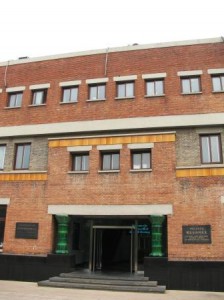
And this is the corridor leading to the long-term cold store.
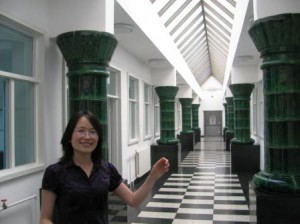
There’s a control room from which you can order a particular tray of accessions.
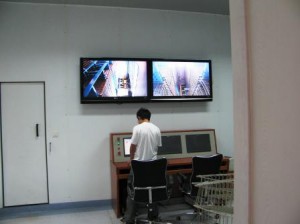
And here it is coming out.

But you can also go into one of the cold stores and pick out individual accessions by hand if you prefer. 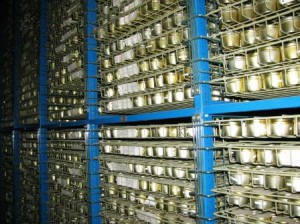
The long-term genebank holds about 356,000 accessions of 735 species, including 72,000 of rice and 45,000 of wheat. The total capacity is about 400,000, so a new facility is being built, with a capacity of 1.5 million accessions. This long-term store is the apex of a national system comprising dozens of mid-term national and local seed genebanks spread throughout the country. Plus of course there are also field and in vitro collections. The whole collection in the national genebank is duplicated at another site in China. Not at Svalbard, though. Yet.
